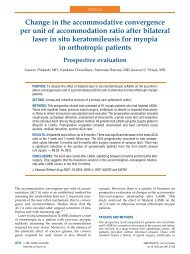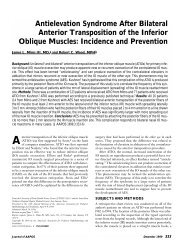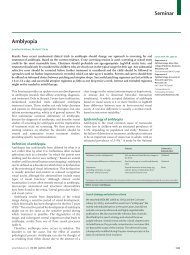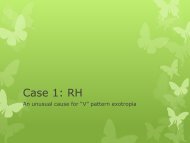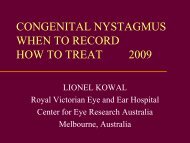What's new AAPOS 2008 - The Private Eye Clinic
What's new AAPOS 2008 - The Private Eye Clinic
What's new AAPOS 2008 - The Private Eye Clinic
You also want an ePaper? Increase the reach of your titles
YUMPU automatically turns print PDFs into web optimized ePapers that Google loves.
Superior oblique tendon damage resulting from eyelid surgery.<br />
Kushner BJ, Jethani JN.<br />
Am J Ophthalmol. 2007 Dec;144(6):943-948. Epub 2007 Oct 22.<br />
PURPOSE: To describe the occurrence of superior oblique (SO) tendon damage<br />
resulting from upper eyelid surgery and to explain its cause and treatment. DESIGN:<br />
Retrospective, observational case series.<br />
METHODS: An institution-based retrospective observational case series of seven<br />
patients in whom damage to the SO tendon secondary to eyelid surgery developed.<br />
RESULTS: In four of the patients, ipsilateral SO palsy developed, and three patients, a<br />
Brown syndrome pattern developed. <strong>The</strong> causative eyelid procedures consisted of<br />
surgery to correct ptosis in four patients, tumor removal in two patients, and cosmetic<br />
blepharoplasty in one patient.<br />
CONCLUSIONS: <strong>The</strong> SO tendon may be damaged as a result of eyelid surgery. <strong>The</strong><br />
anatomy of the SO tendon should be kept in mind while performing surgery in the<br />
superomedial aspect of the upper eyelid.<br />
LASH PTOSIS IN CONGENITAL AND ACQUIRED BLEPHAROPTOSIS<br />
Khurram J Malik MD; Michael S Lee MD; D J John Park MD; Andrew R Harrison MD<br />
Arch Ophthalmol 2007;125(12):1613-1615<br />
<strong>The</strong> objective of this study was to determine the prevalence of lash ptosis (LP) in eyes<br />
with congenital and acquired blepharoptosis. Photographs of 228 eyes from 174<br />
patients with congenital or acquired blepharoptosis were retrospectively graded for LP.<br />
<strong>The</strong> authors used a 4-point rating scale for LP, in which 0 indicates no LP; 1, minimal; 2,<br />
moderate; and 3, severe. A prospective evaluation of LP in 30 eyes from 15 patients<br />
without blepharoptosis (control eyes) was also performed.<br />
A total of 107 eyes (in 87 patients) demonstrated congenital blepharoptosis and 121<br />
eyes (in 87 patients) had acquired blepharoptosis. A moderate to severe rating of LP<br />
(rating, ≥ 2) occurred in 60.7% of eyes with congenital blepharoptosis, 28.9% of eyes<br />
with acquired blepharoptosis, and 6.7% of control eyes. Lash ptosis (rating, ≥ 1) was<br />
present in 91.6% of eyes with congenital blepharoptosis, 83.5% of eyes with acquired<br />
blepharoptosis, and 33.3% of control eyes. <strong>The</strong> mean LP rating was 2.1 for eyes with<br />
congenital blepharoptosis, 1.3 for eyes with acquired blepharoptosis, and 0.6 for control<br />
eyes.<br />
90



